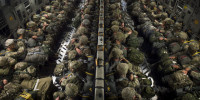



The Costs of War Project is a team of 35 scholars, legal experts, human rights practitioners, and physicians, which began its work in 2011. They use research and a public website to facilitate debate about the costs of the post-9/11 wars in Iraq and Afghanistan, and the related violence in Pakistan and Syria. There are many hidden or unacknowledged costs of the United States’ decision to respond to the 9/11 attacks with military force. They aim to foster democratic discussion of these wars by providing the fullest possible account of their human, economic, and political costs, and to foster better informed public policies.
Neta C. Crawford is the author of Accountability for Killing: Moral Responsibility for Collateral Damage in America's Post-9/11 Wars (Oxford University Press, 2013). Crawford is also the author of two books, Soviet Military Aircraft (1987) and Argument and Change in World Politics (2002), named Best Book in International History and Politics by the American Political Science Association. She has written more than two dozen peer reviewed articles on issues of war and peace. Crawford has served on the governing Board of the Academic Council of the United Nations System, and on the Governing Council of the American Political Science Association.
Some of the Costs of War Project’s main findings include:
-
370,000 people have died due to direct war violence, including armed forces on all sides of the conflicts, contractors, civilians, journalists, and humanitarian workers.
-
It is likely that many times more than 370,000 people have died indirectly in these wars, due to malnutrition, damaged infrastructure, and environmental degradation.
-
200,000 civilians have been killed in direct violence by all parties to these conflicts.
-
Over 6,800 US soldiers have died in the wars.
-
We do not know the full extent of how many US service members returning from these wars became injured or ill while deployed.
-
Many deaths and injuries among US contractors have not been reported as required by law, but it is likely that at least 6,900 have been killed.
-
10.1 million million Afghan, Iraqi, and Pakistani people are living as war refugees and internally displaced persons, in grossly inadequate conditions.*
-
The US has made an estimated 76 drone strikes in Yemen, making the US arguably at war in that country.
-
The wars have been accompanied by erosions in civil liberties and human rights at home and abroad.
-
The human and economic costs of these wars will continue for decades with some costs, such as the financial costs of US veterans’ care, not peaking until mid-century.
-
US government funding of reconstruction efforts in Iraq and Afghanistan has totaled over $170 billion. Most of those funds have gone towards arming security forces in both countries. Much of the money allocated to humanitarian relief and rebuilding civil society has been lost to fraud, waste, and abuse.
-
The cost for the Iraq and Afghanistan/Pakistan wars totals about $4.8 trillion. This does not include future interest costs on borrowing for the wars, which will add an estimated $8 trillion through 2054.
-
The ripple effects on the US economy have also been significant, including job loss and interest rate increases.
-
Both Iraq and Afghanistan continue to rank extremely low in global studies of political freedom.
-
Women in Iraq and Afghanistan are excluded from political power and experience high rates of unemployment and war widowhood.
-
Compelling alternatives to war were scarcely considered in the aftermath of 9/11 or in the discussion about war against Iraq. Some of those alternatives are still available to the US.
- KBOO


